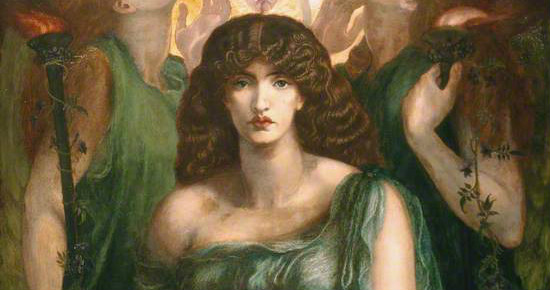I’ve been doing devotionals to deities for several decades. When I started it was difficult to find instructions on how to do it. My working group (Coven of the Mystical Merkabah) invented a method we call the temple-research feedback loop: study the deity, go into temple, use what you’ve learned to refine your research. In recent years as true polytheism has gained traction a number of Pagans have discussed their approaches to making offerings and dedicating to a particular deity. For my money though the most complete, detailed, and sophisticated description of the devotional method is Liber Astarte.
I mentioned this work in my book on theurgy For the Love of the Gods but it deserves a more detailed look. The full name of the book is Astarte vel Liber Berylli sub figura CLXXV (175), subtitled “On uniting oneself to a Deity.” It fits into Thelema and the Golden Dawn system as “Philosophus” work, which means that the operator will have had some training and practice in basic magical skills. This is not intended to be the first thing you ever do when starting down a magical path! It’s a more advanced operation, a way to deepen your understanding of a deity and yourself. At the very least the operator will know how to ground and center, how to set up a protected working space, and have some experience calling deity into a candle or a temple.
Liber Astarte does need some translating. In the Pagan Mysticism blog post Liber Astarte R.M. McGrath notes a couple of things that make it a tough read today. First, it’s written in “Thelemic jargon”, Edwardian English with Crowley’s inimitable style. Those of us who read a lot of Crowley get so used to the dialect that it hardly registers; it’s like attending a Shakespearean play, about fifteen minutes into the experience the language suddenly becomes comprehensible. Crowley is a bit flowery until you get used to him.
Here’s an example. Crowley says:
1. Considerations before the Threshold. First concerning the choice of a particular Deity. This matter is of no import, sobeit that thou choose one suited to thine own highest nature. Howsoever, this method is not so suitable for gods austere as Saturn, or intellectual as Thoth. But for such deities as in themselves partake in anywise of love it is a perfect mode.
Translation: to start with pick any deity, preferably a love deity.
Why a love deity? A Philosophus is doing work associated with the planet Venus, the divine force of love. Starting with a love deity fits in well with the system of Thelema which is based on the love of humans for each other and the love of the divine. Love deities are in general friendly to humans and less likely to make difficult demands than, say, a war deity. Ultimately every deity has every aspect, Aphrodite is also a warrior and Ares is also a lover, but Aphrodite isn’t usually wearing battle armor. We’re looking for a deity whose primary being is focused on love.
McGrath also balks at Liber Astarte’s elaborate recommendations. For example, Crowley directs the practitioner to write a seven-fold prayer and repeat it daily. Certainly it’s possible to do that, but it also works to approach the deity with simple heartfelt words. Similarly the practitioner could perform the invocations for “nine days by seven” or “seven years by nine”, or for a week, month, year, or lifetime. The important thing here is to do the work for however long it is relevant to us.
Understanding that we can translate Crowley’s recommendations to fit the constraints of modern life, his framework is quite thorough. The technique:
- Choose a deity.
- Find or make an image. Set up an altar.
- Make appropriate offerings. This will require research! You can use Qabbalistic correspondences if possible, or figure out what the ancients used. For example the Orphic Hymns specify types of incense for each deity.
Crowley actually says this whole operation doesn’t have to be too complicated. “Likewise with his robes and instruments, his suffumigations and libations: for his Robe hath he not a nightdress; for his instrument a walking stick; for his suffumigation a burning match; for his libation a glass of water?” That is, use what you’ve got!
That’s the first level. Going deeper into devotional, the practitioner can devote every waking moment and conscious act to the deity – eating, sleeping, working, everything we do. Next the operator brings the whole operation internal, making body and mind the temple in which the invocation occurs. Crowley says this in section 17 and it’s easy to skip over, but this is actually a profound shift in the emphasis of the work. This is the action that moves the operation from religious devotional to theurgic invocation. We meet the deities in their images and statues, but more importantly we meet them in ourselves.
Crowley’s later notes discuss how to evaluate the success of the work, describing signs of failure, signs of false success, and then what success actually feels like. Once success has been achieved it is possible to use the connection with deity to consecrate talismans, travel astrally (“Rising on the Planes”), or perform a play enacting the deity’s presence in the world. The goal is union with the deity which is ineffable and is its own reward.
Crowley gives a few cautionary notes. It’s common for an operator to be swept away with the power of the deity and proclaim that deity as the most important in the world, a mistake to be avoided. Also this operation is not the operation of Knowledge and Conversation of the Holy Guardian Angel. Crowley warns the operator not to engage in mortifications, not to withdraw from the world, and not to withdraw affection from family and friends. This is a household devotional which should fit into everyday life.
The book ends, “And so may the love that passeth all Understanding keep your hearts and minds…” Crowley reminds us that devotional is about love – our love for deity, the love of deity for us, and the ways in which that love enriches our families and our lives. Liber Astarte’s approach to devotional is a lovely method and worth the time to explore.



